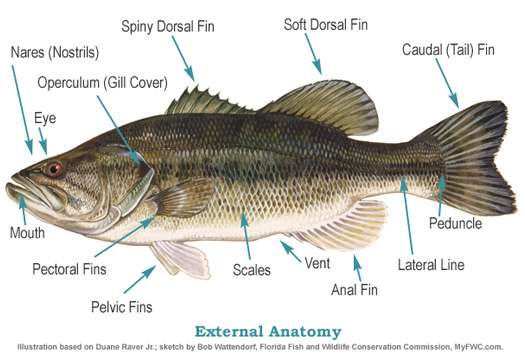
Perhaps the second most important sense for bass is both hearing and feeling. Wait, isn’t that two senses? Well, for a fish, they’re very closely related. In order to understand how a fish hears and feels underwater, we need a quick refresher on physics.
You see, sound is nothing more than energy traveling through a medium. The medium could be a solid, liquid or gas, but there must be the presence of mass in order for sound to travel. When you beat a drum, some of the energy from striking the drum surface is transferred to the air around it via vibrations of the surrounding air particles. These vibrations are passed along to the next particles of air, then the next and next and so on until it reaches your ear, where the vibrating particles cause your ear’s tympanic membrane to vibrate, which your brain interprets as sound.
Sound travels about five times faster in water than it does in air, and about five times faster again in a solid like steel. The denser the medium, the more particles there are to vibrate and the faster energy can be passed from one particle to another.
Now, back to what this means for bass. Water is already much more efficient at transferring sounds than air, so bass — and fish in general — are able to detect sounds more quickly and efficiently than humans. But how do they do it? They obviously don’t have ears … or do they?
Although they don’t have external oratory canals, bass do have internal ears that allow them to hear sound in the water, just as we do in air. Their inner ear also serves to help orient them in the water, just as our inner ear helps us to maintain our balance by telling our brain which way we are leaning.
However, fish take hearing underwater a step further. Bass, like most freshwater fish, have an additional sensory organ for their underwater environment — the lateral line. Now, I’m not talking about the long, wide black color blotches that run down the side of a largemouth or spotted bass.
The lateral line is a series of pores or canals in a row of scales that stretch from just behind the gill plate to nearly the tail in a bass. They are perceptible, but you have to look closely. These canals contain a series of cells that have hair-like extensions surrounded by a gelatinous substance, together called neuromasts. Vibrations from surrounding water on one or more of these groups of cells send a signal to the bass’ brain that — along with the same effects on the inner ear — it interprets as sound.
So how do bass feel? They obviously don’t have digits with extra sensitive nerves under their skin as we do. However, like with sound, the system of neuromasts in the lateral line can also sense the slightest changes in water pressure. When another fish swims by, the resulting difference in water pressure from the moving fish travels to the bass in waves. When the hair-like structures in the nueromasts are bent in a certain direction from the resulting wave pressure, they tell the bass not only what happened, but where in relation to the bass’ position and in what direction the movement occurred.
Pretty amazing, isn’t it? The lateral line not only allows fish to hear underwater, but it enables them to feel what is going on in the neighborhood.
Anybody that’s ever ripped a lipless crankbait through the grass knows that sound travels very well in water, as evidenced by the rapid ticking noise emanating through the bottom of the boat as you sweep the lure. On days when bass are reacting to the bait without much scrutiny, or when the water conditions and light are such that they can’t see it very well, a loud lure certainly gets their attention.
However, even if you’re fishing a good ol’ Texas-rigged worm without any rattles, rest assured that if you get it close to a bass, it’ll know where it is, even if it can’t see it.
Originally published January 2011




